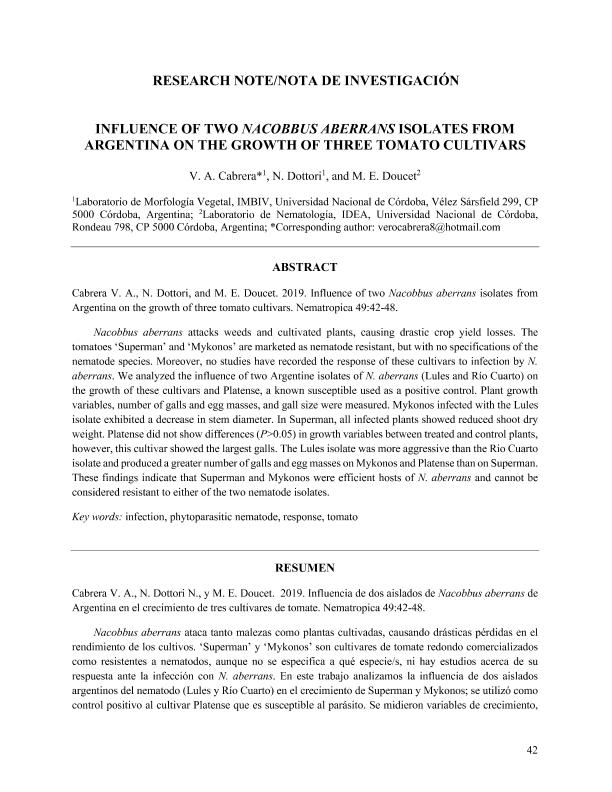Mostrar el registro sencillo del ítem
dc.contributor.author
Cabrera, Verónica Alejandra

dc.contributor.author
Dottori, Nilda Mirta

dc.contributor.author
Doucet, Marcelo Edmundo

dc.date.available
2021-02-22T16:25:39Z
dc.date.issued
2019-10-08
dc.identifier.citation
Cabrera, Verónica Alejandra; Dottori, Nilda Mirta; Doucet, Marcelo Edmundo; Influence of two Nacobbus aberrans isolates from Argentina on the growth of three tomato cultivars; Organization Trop Amer Nematologists; Nematropica; 49; 1; 8-10-2019; 42-48
dc.identifier.issn
0099-5444
dc.identifier.uri
http://hdl.handle.net/11336/126247
dc.description.abstract
Nacobbus aberrans ataca tanto malezas como plantas cultivadas, causando drásticas pérdidas en el rendimiento de los cultivos. ʻSupermanʼ y ʻMykonosʼ son cultivares de tomate redondo comercializados como resistentes a nematodos, aunque no se especifica a qué especie/s, ni hay estudios acerca de su respuesta ante la infección con N. aberrans. En este trabajo analizamos la influencia de dos aislados argentinos del nematodo (Lules y Río Cuarto) en el crecimiento de Superman y Mykonos; se utilizó como control positivo al cultivar Platense que es susceptible al parásito. Se midieron variables de crecimiento, cantidad de agallas y masas de huevos por sistema radical y tamaño de las agallas. En el cultivar Mykonos disminuyó el diámetro del tallo cuando se infectó con el aislado Lules; en Superman, las plantas infectadas evidenciaron menor peso seco aéreo que las sanas. No se encontraron diferencias significativas para las variables de crecimiento en el cultivar Platense, aunque fue el que presentó las agallas de mayor tamaño. El aislado proveniente de Lules fue más agresivo que el de Río Cuarto, generando mayor cantidad de agallas y masas de huevos en Mykonos y Platense que en Superman. Los cultivares evaluados fueron hospedadores eficientes del parásito, por lo que no pueden considerarse resistentes a los aislados utilizados.
dc.description.abstract
Nacobbus aberrans attacks weeds and cultivated plants, causing drastic crop yield losses. Thetomatoes ʻSupermanʼ and ʻMykonosʼ are marketed as nematode resistant, but with no specifications of the nematode species. Moreover, no studies have recorded the response of these cultivars to infection by N. aberrans. We analyzed the influence of two Argentine isolates of N. aberrans (Lules and Río Cuarto) on the growth of these cultivars and Platense, a known susceptible used as a positive control. Plant growth variables, number of galls and egg masses, and gall size were measured. Mykonos infected with the Lules isolate exhibited a decrease in stem diameter. In Superman, all infected plants showed reduced shoot dry weight. Platense did not show differences (P>0.05) in growth variables between treated and control plants, however, this cultivar showed the largest galls. The Lules isolate was more aggressive than the Rio Cuarto isolate and produced a greater number of galls and egg masses on Mykonos and Platense than on Superman.These findings indicate that Superman and Mykonos were efficient hosts of N. aberrans and cannot be considered resistant to either of the two nematode isolates
dc.format
application/pdf
dc.language.iso
eng
dc.publisher
Organization Trop Amer Nematologists

dc.rights
info:eu-repo/semantics/openAccess
dc.rights.uri
https://creativecommons.org/licenses/by-nc-sa/2.5/ar/
dc.subject
INFECTION
dc.subject
PHYTOPARASITIC NEMATODE
dc.subject
RESPONSE
dc.subject
TOMATO
dc.subject.classification
Otras Ciencias Biológicas

dc.subject.classification
Ciencias Biológicas

dc.subject.classification
CIENCIAS NATURALES Y EXACTAS

dc.title
Influence of two Nacobbus aberrans isolates from Argentina on the growth of three tomato cultivars
dc.type
info:eu-repo/semantics/article
dc.type
info:ar-repo/semantics/artículo
dc.type
info:eu-repo/semantics/publishedVersion
dc.date.updated
2020-11-27T18:09:27Z
dc.journal.volume
49
dc.journal.number
1
dc.journal.pagination
42-48
dc.journal.pais
Estados Unidos

dc.journal.ciudad
Florida
dc.description.fil
Fil: Cabrera, Verónica Alejandra. Consejo Nacional de Investigaciones Científicas y Técnicas. Centro Científico Tecnológico Conicet - Córdoba. Instituto Multidisciplinario de Biología Vegetal. Universidad Nacional de Córdoba. Facultad de Ciencias Exactas Físicas y Naturales. Instituto Multidisciplinario de Biología Vegetal; Argentina
dc.description.fil
Fil: Dottori, Nilda Mirta. Consejo Nacional de Investigaciones Científicas y Técnicas. Centro Científico Tecnológico Conicet - Córdoba. Instituto Multidisciplinario de Biología Vegetal. Universidad Nacional de Córdoba. Facultad de Ciencias Exactas Físicas y Naturales. Instituto Multidisciplinario de Biología Vegetal; Argentina
dc.description.fil
Fil: Doucet, Marcelo Edmundo. Consejo Nacional de Investigaciones Científicas y Técnicas. Centro Científico Tecnológico Conicet - Córdoba. Instituto de Diversidad y Ecología Animal. Universidad Nacional de Córdoba. Facultad de Ciencias Exactas Físicas y Naturales. Instituto de Diversidad y Ecología Animal; Argentina
dc.journal.title
Nematropica

dc.relation.alternativeid
info:eu-repo/semantics/altIdentifier/url/https://journals.flvc.org/nematropica/article/view/115545
Archivos asociados
